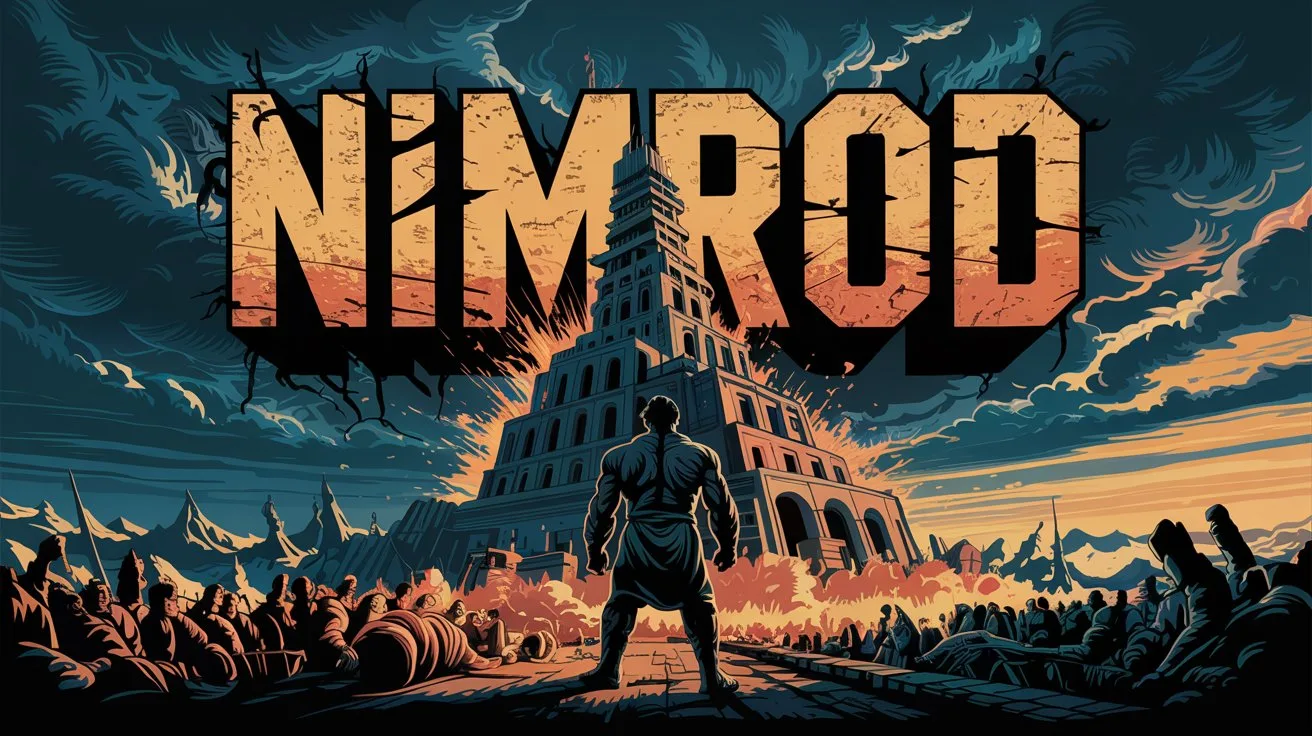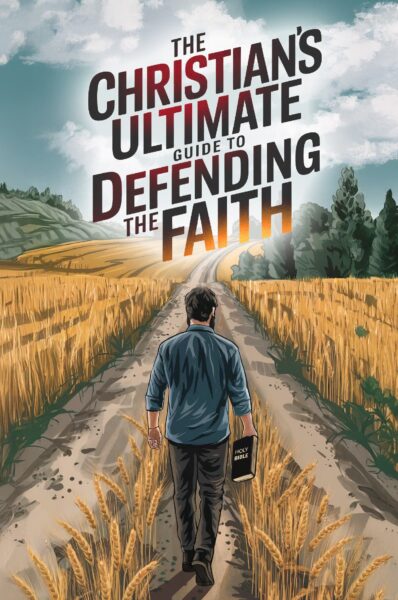The first mention of Nimrod is found in Genesis 10:8-9, in the genealogy of Noah’s descendants after the Flood. The Scripture says,
“Cush begot Nimrod; he began to be a mighty one on the earth. He was a mighty hunter before the Lord; therefore it is said, ‘Like Nimrod the mighty hunter before the Lord.’”
Here, Nimrod is introduced not just as a man, but as someone distinct among men, a “mighty one” on the earth. The language suggests an elevation above normal humanity, which hints at a deeper, possibly supernatural element. Further, Genesis 10:10 states,
“And the beginning of his kingdom was Babel, Erech, Accad, and Calneh, in the land of Shinar.”
Nimrod was not merely a hunter; he was a builder of cities and empires. Babel (later known as Babylon) becomes the spiritual center of rebellion against God.
The Hebrew word for “mighty” here is gibbor (גִּבּוֹר), the same term used in Genesis 6:4 for the “mighty men” (gibborim) born of the union between the “sons of God” and the “daughters of men,” identified as the Nephilim. This linguistic parallel strongly hints that Nimrod could have been either of Nephilim descent or influenced by that corrupted, pre-Flood bloodline that somehow survived through the Flood, possibly via the wife of Ham or others (a common theological consideration).
The Nephilim and the Post-Flood World
Genesis 6:4 says,
“There were giants on the earth in those days, and also afterward…”
The phrase “and also afterward” implies that the Nephilim influence continued after the Flood, setting the stage for figures like Nimrod. This echoes Numbers 13:33, where the spies report,
“There we saw the giants (the descendants of Anak came from the giants); and we were like grasshoppers in our own sight, and so we were in their sight.”
Giants clearly persisted after the Flood, which opens the door for Nimrod, as a descendant of Cush through Ham, to potentially bear some form of hybrid bloodline or Nephilim corruption.
Nimrod and the Cities of Rebellion
The Bible is precise in its record of Nimrod’s exploits as a kingdom-builder. Genesis 10:10 states,
“And the beginning of his kingdom was Babel, Erech, Accad, and Calneh, in the land of Shinar.”
These were the first centers of organized rebellion against God after the Flood, unified under Nimrod’s leadership.
Babel
Babel (Hebrew בָּבֶל, Bāḇel) would later become Babylon. It was located in the plain of Shinar (modern southern Iraq). Babel represents the first organized system of idolatry and false religion. Genesis 11:4 records mankind’s unified goal at Babel: “Come, let us build ourselves a city, and a tower whose top is in the heavens; let us make a name for ourselves, lest we be scattered abroad over the face of the whole earth.” This rebellion was centralized under Nimrod’s leadership.
Erech
Erech (Sumerian Unug, Akkadian Uruk) corresponds to the archaeological site of modern Warka. It is the same Uruk associated with Gilgamesh in the Sumerian texts. Uruk was one of the first major cities in the world, known for its massive walls and ziggurat-style structures. In the Epic of Gilgamesh, the massive walls of Uruk are a testament to the king’s might (paralleling the biblical record of Nimrod as a great city-builder).
Accad
Accad (Akkadian Akkadu) became the central city of the Akkadian Empire founded by Sargon of Akkad. While not much is directly recorded about Accad in the Bible beyond its mention here, archaeological findings confirm its place as one of the earliest empire capitals. Nimrod laying its foundation shows his ambition to establish dominion over a vast and expanding territory.
Calneh
Calneh’s exact identification remains debated among scholars. Some suggest it is a city that has not been conclusively excavated yet. Others believe Calneh could symbolically represent a broader area or group of cities in Shinar, emphasizing the wide extent of Nimrod’s control.
The Kingdom Expansion: Assyria and Beyond
Interestingly, Genesis 10:11-12 reads:
“From that land he went to Assyria and built Nineveh, Rehoboth Ir, Calah, and Resen between Nineveh and Calah (that is the principal city).”
This implies that Nimrod himself went into Assyria and built more cities, not just local to Shinar but expanding northward.
Nineveh: Later the capital of the Assyrian empire, and an object of God’s judgment in the book of Jonah.
Rehoboth Ir: Likely meaning “Wide Streets of the City,” signifying a major urban center.
Calah: Modern-day Nimrud; an important Assyrian city.
Resen: Situated between Nineveh and Calah; known to be a “great city.”
This passage reveals that Nimrod’s influence was not limited to Babel and the cities in Shinar (it stretched into Assyria), suggesting he was not just a local king but a proto-emperor.
There is a slight textual ambiguity between manuscripts. The Masoretic Text suggests it was Nimrod who founded these cities; but the Septuagint (less trustworthy manuscript) implies it might have been Asshur, the person. However, the reading that Nimrod continued his expansion is stronger contextually, given that he is already building an empire (Genesis 10:8-10).
Symbolism of the Cities
Each city associated with Nimrod later became infamous for rebellion against God:
Babel/Babylon: The origin of false religion, mentioned heavily in Revelation 17–18.
Nineveh: Symbol of cruelty and oppression, later rebuked through the prophet Jonah.
Uruk (Erech): Rooted in the legends of Gilgamesh, celebrated man’s might without God.
Accad and Calah: Centers of human empire-building opposed to divine kingship.
Thus, Nimrod’s cities were not just political centers but spiritual strongholds of defiance against God’s rule.
Connecting Nimrod to Gilgamesh
Ancient Sumerian and Akkadian texts, notably the Epic of Gilgamesh, tell the story of a king of Uruk (biblical Erech) who was described as two-thirds god and one-third man, a powerful warrior and builder of massive walls, defier of the gods’ commands, and seeker of immortality.
The Sumerian King List names a ruler of Uruk named Gilgamesh, stating he reigned for 126 years. Significantly, Gilgamesh is described in the Epic as having great strength, building Uruk’s walls, and warring against the gods’ will, which mirrors the idea of Nimrod building Babel and leading a rebellion against God (Genesis 11:1-9). Josephus, the first-century Jewish historian, writes in Antiquities of the Jews 1.4.2 that Nimrod
“persuaded [men] not to ascribe [their strength] to God, as if it was through his means they were happy, but to believe that it was their own courage which procured that happiness.”
Josephus also says Nimrod
“gradually changed the government into tyranny, seeing no other way of turning men from the fear of God, but to bring them into a constant dependence on his power.”
This matches Gilgamesh’s character exactly: a powerful but tyrannical leader, resistant to divine authority. Thus, it is very reasonable (based on geographic, historical, and literary evidence) to equate Nimrod with Gilgamesh. Both were associated with Uruk/Erech, both built massive cities, were known for rebellion, were described with supernatural qualities, and both exhibited traits linked to the Nephilim.
Historical Sources Supporting the Link
The Epic of Gilgamesh: Describes Gilgamesh as two-thirds divine, great in strength, associated with Erech/Uruk, just like Nimrod.
Sumerian King List: Confirms a king named Gilgamesh ruled Uruk.
Josephus, Antiquities of the Jews: Nimrod was a tyrant who sought to lead people in rebellion against God.
Encyclopedia Britannica: Notes that Gilgamesh is depicted as a demigod and mighty warrior king.
Alexander Hislop’s “The Two Babylons” (1858): Suggests Nimrod was deified after death and connects him to the early pagan systems.
Eusebius of Caesarea: References early traditions that tie Nimrod to the foundation of Babylonian worship and empire.
Was Nimrod a Nephilim?
Based on the term gibbor, the parallels to Genesis 6:4, and the descriptions from extra-biblical sources of Gilgamesh being part divine and of superhuman strength, it is highly probable that Nimrod was either of Nephilim descent, or he was empowered by the same demons/”>demonic spirits that had corrupted mankind before the Flood.
The post-Flood continuation of the Nephilim is clearly acknowledged by Scripture and history alike, and Nimrod fits the profile exactly.
Babel: The Pinnacle of Rebellion
Nimrod’s crowning act was the construction of Babel, where mankind united to build a tower
“whose top is in the heavens” (Genesis 11:4).
This was not merely an architectural feat but a religious rebellion, an attempt to create an artificial gateway to the divine without submission to God. Thus, Nimrod mirrors the same Luciferian rebellion seen in Isaiah 14:13-14, where Lucifer says,
“I will ascend into heaven, I will exalt my throne above the stars of God…”
Nimrod’s efforts echo this satanic ambition, positioning himself as a counterfeit messiah figure in the earliest days of post-Flood humanity.
My Final Thoughts
Nimrod stands as one of the first great figures of rebellion after the Flood. Scripture paints him as a “mighty one” (gibbor), using language tied to the pre-Flood giants, suggesting he was more than human. Ancient texts and traditions associate Nimrod with Gilgamesh, a figure likewise described as semi-divine, mighty, and rebellious. Historically, culturally, and exegetically, the link between Nimrod, the Nephilim, and Gilgamesh is compelling.
Understanding Nimrod helps us grasp the roots of all human government and false religious systems that would later emerge, as seen in Revelation 17–18 with Mystery Babylon. It reminds us that the spirit of rebellion against God began early, but God’s judgment at Babel scattered mankind, preserving His plan for redemption through a chosen seed, ultimately fulfilled in Jesus Christ.
As we study Nimrod, let us also be cautious against pride, rebellion, and human self-exaltation in our own lives. God alone is the Most High, and all attempts to “build a tower to heaven” without Him will fall.





 Get the book that teaches you how to evangelize and disarm doctrines from every single major cult group today.
Get the book that teaches you how to evangelize and disarm doctrines from every single major cult group today.